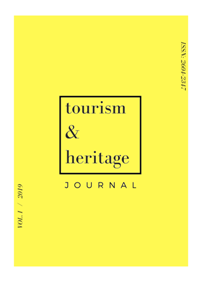Intangible heritage through mediation proposals in tourist cities: the case of Sarrià-Sant Gervasi in Barcelona.
DOI:
https://doi.org/10.1344/THJ.2019.1.4Keywords:
Barcelona, intangible heritage, mediation, put in value, tourist itinerary.Abstract
In many occasions, intangible cultural heritage can be illegible for those who would like to enjoy it due to its immateriality. That is why this article aims to take down these barriers through three mediation proposals for a touristic-cultural route in the district of Sarrià - Sant Gervasi (Barcelona). Moreover, another goal is to decentralize the touristic activity of the city, increasing the cultural offer in off-the-beaten track areas. Specifically, this itinerary aims to explain the history of the district through its most relevant individuals, emphasizing their heritage elements, facts, curiosities and anecdotes of the neighbourhood. The three mediation proposals are: a theatralised visit where the participants are the actors, a visit guided by QR codes that raise questions to the users and a nocturnal terror visit that finalizes with an escape room. Finally, some future researches are suggested linked to the tourists cities and the specific proposal.References
Ajuntament de Barcelona. PEUAT. http://ajuntament.barcelona.cat/pla-allotjaments-turistics/ca/ (Recuperat el 19 de febrer de 2019).
Ajuntament de Barcelona. Pla estratègic. https://ajuntament.barcelona.cat/turisme/ca/pla-estrategic
(Recuperat el 20 de febrer de 2019).
Ajuntament de Barcelona. Turisme. https://ajuntament.barcelona.cat/turisme/ca/estadistiques_enquestes (Recuperat el 19 de febrer de 2019).
Ashworth, G. i Page, S. (2011). Urban tourism research: Recent progress and current paradoxes. Tourism Management, 32, 1-15.
Cabrera, J., Galella, F. i Llevot, C. (2014). Estan prou preparades les destinacions actuals per acollir els seus visitants? (bachelor’s thesis). CETT-UB, Barcelona.
Casanovas, O. (2017). Turismo y convivencia ciudadana. A Coma, L. i Santacana, J. (coord), Ciudad educadora y turismo responsable (pp. 135-141). Gijón: Ediciones Trea.
Casanovas, A. i Arcos, J. (2017). Protección del patrimonio y su contexto: de la conservación a la preservación. A Coma, L. i Santacana, J. (coord), Ciudad educadora y turismo responsable (pp. 213-230). Gijón: Ediciones Trea.
Coma, L. i Conill, M. (2017) Buenas prácticas de turismo responsable desde y en las ciudades educadoras. A Coma, L. i Santacana, J. (coord), Ciudad educadora y turismo responsable (pp. 161-174). Gijón: Ediciones Trea.
Coma, L. i Santacana, J. (2010). Ciudad educadora y patrimonio. Cookbook of heritage. (1a ed.). Gijón: Ediciones Trea.
Euromonitor International. (2019). Top 100 City Destinations 2018. http://go.euromonitor.com/rs/805-KOK-719/images/wpTop100CitiesEN_Final.pdf?mkt_tok=eyJpIjoiTlRZNE1tWmpZVFUyWmpWbSIsInQiOiI5SDhtU0FcL2dHVzV6d3BPdUYyMk9iZGNcLzdcL0F4SU9WWVVzMjdlcVlRUVgwdlpLV0FpZER0Y1Q4UCtBK2ZISVdQZjVmRDhHRFlPTWFtODZ2NFhNSXpKNjlEMGtWSkFseDcwWW1pOGxUdjBKcHdwc2lKRmttRWZ1K2NhWTN5MXRCVCJ9
Fontal, O. (2013). La educación patrimonial. Del patrimonio a las personas. (1a ed.). Gijón: Ediciones Trea.
Garcia, A., Linaza, M., Gutierrez, A. i Garcia, E. (2018). Gamified mobile experiences: smart technologies for tourism destinations. Tourism Review, 74, (1), 30-49.
Guitart, N. (2018). De la Turismofobia a la Convivencia Turística: El Caso de Barcelona. Análisis Comparativo con Ámsterdam y Berlín. ARA: Journal of Tourism Research, 8, (2), 25-34.Imbert-Bouchard, D. (2017). El turismo y su componente geográfico y territorial. A Coma, L. i Santacana, J. (coord), Ciudad educadora y turismo responsable (pp. 123-129). Gijón: Ediciones Trea.
Llonch, N. i Santacana, J. (2015). El patrimonio cultural inmaterial y su didáctica. (1a ed.). Gijón: Ediciones Trea.
López Palomeque, F. (2015). Barcelona, de ciutat amb turisme a ciutat turística. Documents d’Anàlisi Geogràfica, 61 (3).
Niemelä, T. (2010). Nature and Soft Adventure Tourism (bachelor’s thesis). Lathi University of Applied Science, Lathi.
Observatori Dades Culturals Barcelona. http://barcelonadadescultura.bcn.cat/equipaments/(Recuperat el 20 de febrer de 2019).
OMT. (6 de novembre de 2017). El turismo internacional hacia otro año de crecimiento. OMT. Recuperat el 20 de febrer de 2019. http://media.unwto.org/es/press-release/2017-11-07/el-turismo-internacional-hacia-otro-ano-de-crecimiento
OMT & IPSOS. (2019). Estudio global sobre la percepción de los residentes hacia el turismo urbano: impacto y medidas. Recuperat el 20 de febrer de 2019. http://cf.cdn.unwto.org/sites/all/files/docpdf/omtipsosestudioglobalresumen.pdf
Ruiz-Ballesteros, E., Hernández, M., Coca, A., Cantero, P. i del Campo, A. (2008). Turismo comunitario en Ecuador. Pasos, 6, (3), 399-418.
Solima, L. i Izzo, F. (2017). QR Codes in cultural heritage tourism: new communications technologies and future prospects in Naples and Warsaw. Journal of Heritage Tourism, 13, (1), 115-117.
Tilden, F. (1977). Interpreting Our Heritage. Chapel Hill: University of North Carolina Press.
UNESCO, (2003), Convention for the Safeguarding of the intangible cultural heritage, UNESCO, Paris.
UNESCO (2014). Indicadores UNESCO de cultura para el desarrollo. https://es.unesco.org/creativity/sites/creativity/files/digital-library/cdis/Patrimonio.pdf
Van Es, N. i Reijnders, S. (2016). Making sense of capital crime cities: Getting underneath the urban facade on crime-detective fiction tours. European Journal of Cultural Studies, 21(4), 502–520.
Downloads
Published
How to Cite
Issue
Section
License
The authors who publish in this journal agree to the following terms:
- Authors retain copyright and grant the journal the right of first publication.
- Texts will be published under a Creative Commons Attribution License that allows others to share the work, provided they include an acknowledgement of the work’s authorship, its initial publication in this journal and the terms of the license.




